Dario Farina
Imitation Learning for Adaptive Control of a Virtual Soft Exoglove
May 14, 2025Abstract:The use of wearable robots has been widely adopted in rehabilitation training for patients with hand motor impairments. However, the uniqueness of patients' muscle loss is often overlooked. Leveraging reinforcement learning and a biologically accurate musculoskeletal model in simulation, we propose a customized wearable robotic controller that is able to address specific muscle deficits and to provide compensation for hand-object manipulation tasks. Video data of a same subject performing human grasping tasks is used to train a manipulation model through learning from demonstration. This manipulation model is subsequently fine-tuned to perform object-specific interaction tasks. The muscle forces in the musculoskeletal manipulation model are then weakened to simulate neurological motor impairments, which are later compensated by the actuation of a virtual wearable robotics glove. Results shows that integrating the virtual wearable robotic glove provides shared assistance to support the hand manipulator with weakened muscle forces. The learned exoglove controller achieved an average of 90.5\% of the original manipulation proficiency.
Switch-based Independent Antagonist Actuation with a Single Motor for a Soft Exosuit
Feb 07, 2025



Abstract:The use of a cable-driven soft exosuit poses challenges with regards to the mechanical design of the actuation system, particularly when used for actuation along multiple degrees of freedom (DoF). The simplest general solution requires the use of two actuators to be capable of inducing movement along one DoF. However, this solution is not practical for the development of multi-joint exosuits. Reducing the number of actuators is a critical need in multi-DoF exosuits. We propose a switch-based mechanism to control an antagonist pair of cables such that it can actuate along any cable path geometry. The results showed that 298.24ms was needed for switching between cables. While this latency is relatively large, it can reduced in the future by a better choice of the motor used for actuation.
Unlocking the Full Potential of High-Density Surface EMG: Novel Non-Invasive High-Yield Motor Unit Decomposition
Oct 18, 2024Abstract:The decomposition of high-density surface electromyography (HD-sEMG) signals into motor unit discharge patterns has become a powerful tool for investigating the neural control of movement, providing insights into motor neuron recruitment and discharge behavior. However, current algorithms, while very effective under certain conditions, face significant challenges in complex scenarios, as their accuracy and motor unit yield are highly dependent on anatomical differences among individuals. This can limit the number of decomposed motor units, particularly in challenging conditions. To address this issue, we recently introduced Swarm-Contrastive Decomposition (SCD), which dynamically adjusts the separation function based on the distribution of the data and prevents convergence to the same source. Initially applied to intramuscular EMG signals, SCD is here adapted for HD-sEMG signals. We demonstrated its ability to address key challenges faced by existing methods, particularly in identifying low-amplitude motor unit action potentials and effectively handling complex decomposition scenarios, like high-interference signals. We extensively validated SCD using simulated and experimental HD-sEMG recordings and compared it with current state-of-the-art decomposition methods under varying conditions, including different excitation levels, noise intensities, force profiles, sexes, and muscle groups. The proposed method consistently outperformed existing techniques in both the quantity of decoded motor units and the precision of their firing time identification. For instance, under certain experimental conditions, SCD detected more than three times as many motor units compared to previous methods, while also significantly improving accuracy. These advancements represent a major step forward in non-invasive EMG technology for studying motor unit activity in complex scenarios.
Intramuscular High-Density Micro-Electrode Arrays Enable High-Precision Decoding and Mapping of Spinal Motor Neurons to Reveal Hand Control
Oct 14, 2024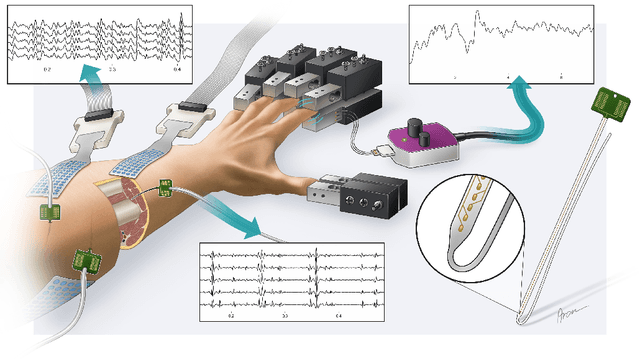
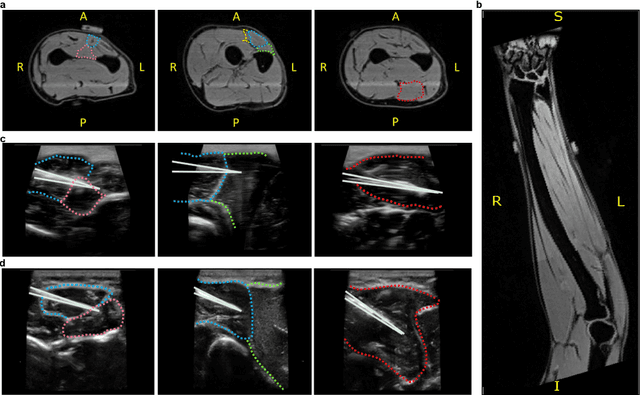
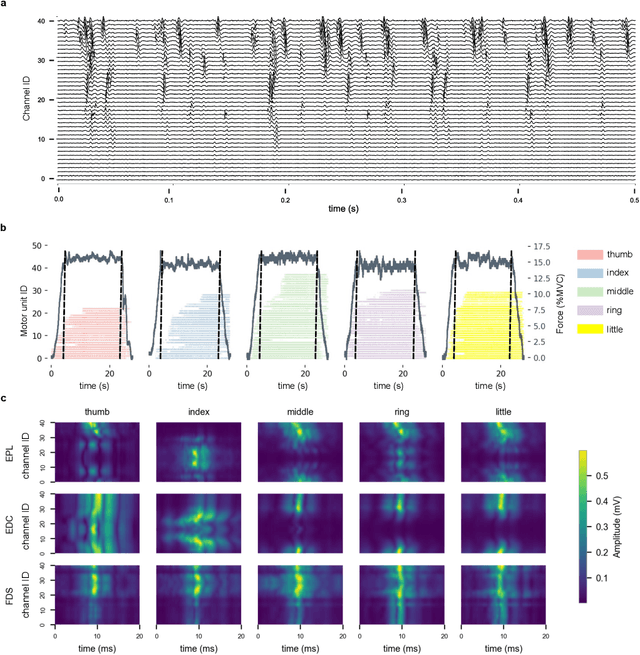
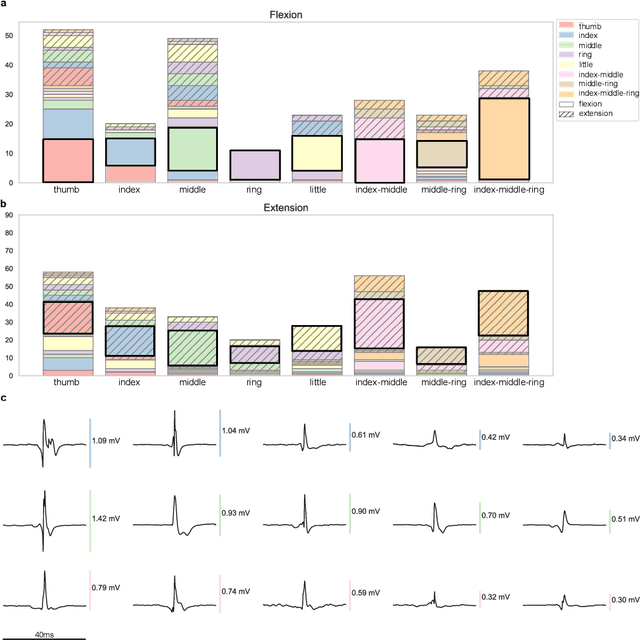
Abstract:Decoding nervous system activity is a key challenge in neuroscience and neural interfacing. In this study, we propose a novel neural decoding system that enables unprecedented large-scale sampling of muscle activity. Using micro-electrode arrays with more than 100 channels embedded within the forearm muscles, we recorded high-density signals that captured multi-unit motor neuron activity. This extensive sampling was complemented by advanced methods for neural decomposition, analysis, and classification, allowing us to accurately detect and interpret the spiking activity of spinal motor neurons that innervate hand muscles. We evaluated this system in two healthy participants, each implanted with three electromyogram (EMG) micro-electrode arrays (comprising 40 electrodes each) in the forearm. These arrays recorded muscle activity during both single- and multi-digit isometric contractions. For the first time under controlled conditions, we demonstrate that multi-digit tasks elicit unique patterns of motor neuron recruitment specific to each task, rather than employing combinations of recruitment patterns from single-digit tasks. This observation led us to hypothesize that hand tasks could be classified with high precision based on the decoded neural activity. We achieved perfect classification accuracy (100%) across 12 distinct single- and multi-digit tasks, and consistently high accuracy (>96\%) across all conditions and subjects, for up to 16 task classes. These results significantly outperformed conventional EMG classification methods. The exceptional performance of this system paves the way for developing advanced neural interfaces based on invasive high-density EMG technology. This innovation could greatly enhance human-computer interaction and lead to substantial improvements in assistive technologies, offering new possibilities for restoring motor function in clinical applications.
Separation of Neural Drives to Muscles from Transferred Polyfunctional Nerves using Implanted Micro-electrode Arrays
Oct 14, 2024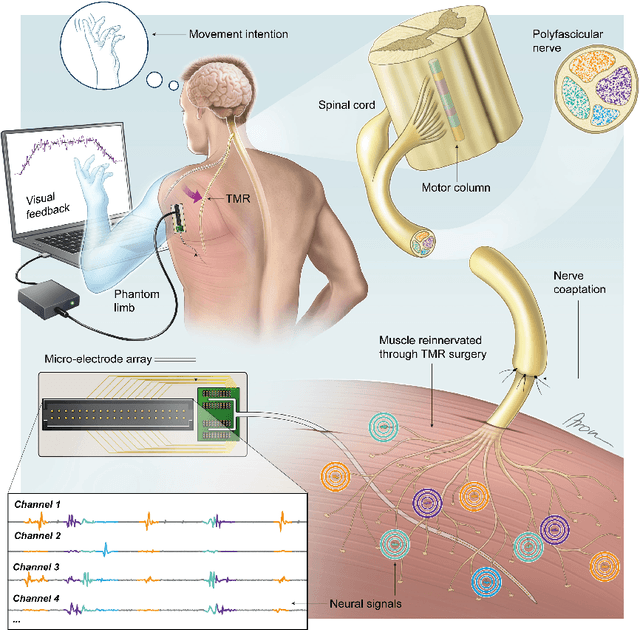
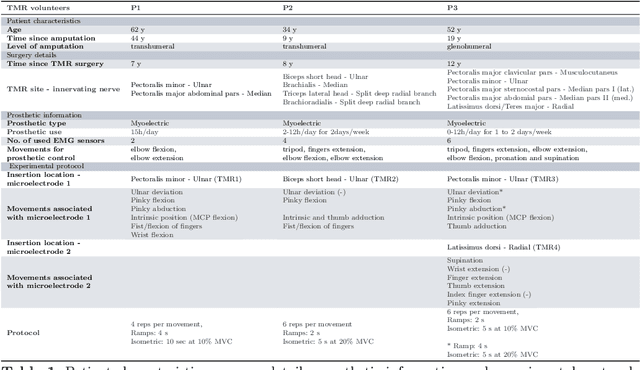
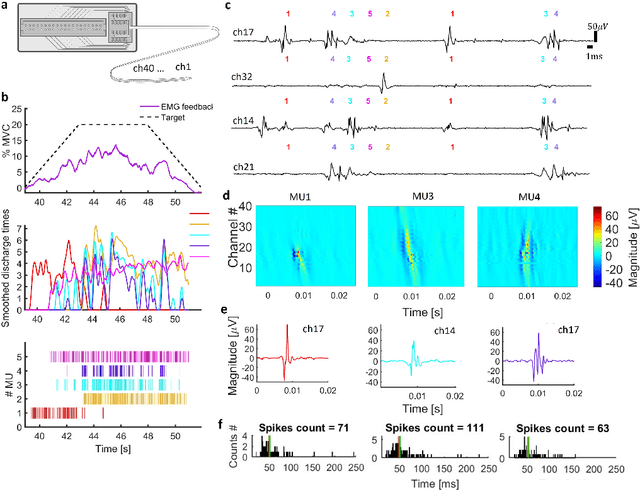

Abstract:Following limb amputation, neural signals for limb functions persist in the residual peripheral nerves. Targeted muscle reinnervation (TMR) allows to redirected these signals into spare muscles to recover the neural information through electromyography (EMG). However, a significant challenge arises in separating distinct neural commands redirected from the transferred nerves to the muscles. Disentangling overlapping signals from EMG recordings remains complex, as they can contain mixed neural information that complicates limb function interpretation. To address this challenge, Regenerative Peripheral Nerve Interfaces (RPNIs) surgically partition the nerve into individual fascicles that reinnervate specific muscle grafts, isolating distinct neural sources for more precise control and interpretation of EMG signals. We introduce a novel biointerface that combines TMR surgery of polyvalent nerves with a high-density micro-electrode array implanted at a single site within a reinnervated muscle. Instead of surgically identifying distinct nerve fascicles, our approach separates all neural signals that are re-directed into a single muscle, using the high spatio-temporal selectivity of the micro-electrode array and mathematical source separation methods. We recorded EMG signals from four reinnervated muscles while volunteers performed phantom limb tasks. The decomposition of these signals into motor unit activity revealed distinct clusters of motor neurons associated with diverse functional tasks. Notably, our method enabled the extraction of multiple neural commands within a single reinnervated muscle, eliminating the need for surgical nerve division. This approach not only has the potential of enhancing prosthesis control but also uncovers mechanisms of motor neuron synergies following TMR, providing valuable insights into how the central nervous system encodes movement after reinnervation.
Spatial Adaptation Layer: Interpretable Domain Adaptation For Biosignal Sensor Array Applications
Sep 12, 2024



Abstract:Biosignal acquisition is key for healthcare applications and wearable devices, with machine learning offering promising methods for processing signals like surface electromyography (sEMG) and electroencephalography (EEG). Despite high within-session performance, intersession performance is hindered by electrode shift, a known issue across modalities. Existing solutions often require large and expensive datasets and/or lack robustness and interpretability. Thus, we propose the Spatial Adaptation Layer (SAL), which can be prepended to any biosignal array model and learns a parametrized affine transformation at the input between two recording sessions. We also introduce learnable baseline normalization (LBN) to reduce baseline fluctuations. Tested on two HD-sEMG gesture recognition datasets, SAL and LBN outperform standard fine-tuning on regular arrays, achieving competitive performance even with a logistic regressor, with orders of magnitude less, physically interpretable parameters. Our ablation study shows that forearm circumferential translations account for the majority of performance improvements, in line with sEMG physiological expectations.
HarmonICA: Neural non-stationarity correction and source separation for motor neuron interfaces
Jun 28, 2024Abstract:A major outstanding problem when interfacing with spinal motor neurons is how to accurately compensate for non-stationary effects in the signal during source separation routines, particularly when they cannot be estimated in advance. This forces current systems to instead use undifferentiated bulk signal, which limits the potential degrees of freedom for control. In this study we propose a potential solution, using an unsupervised learning algorithm to blindly correct for the effects of latent processes which drive the signal non-stationarities. We implement this methodology within the theoretical framework of a quasilinear version of independent component analysis (ICA). The proposed design, HarmonICA, sidesteps the identifiability problems of nonlinear ICA, allowing for equivalent predictability to linear ICA whilst retaining the ability to learn complex nonlinear relationships between non-stationary latents and their effects on the signal. We test HarmonICA on both invasive and non-invasive recordings both simulated and real, demonstrating an ability to blindly compensate for the non-stationary effects specific to each, and thus to significantly enhance the quality of a source separation routine.
Space Physiology and Technology: Musculoskeletal Adaptations, Countermeasures, and the Opportunity for Wearable Robotics
Apr 04, 2024Abstract:Space poses significant challenges for human physiology, leading to physiological adaptations in response to an environment vastly different from Earth. While these adaptations can be beneficial, they may not fully counteract the adverse impact of space-related stressors. A comprehensive understanding of these physiological adaptations is needed to devise effective countermeasures to support human life in space. This review focuses on the impact of the environment in space on the musculoskeletal system. It highlights the complex interplay between bone and muscle adaptation, the underlying physiological mechanisms, and their implications on astronaut health. Furthermore, the review delves into the deployed and current advances in countermeasures and proposes, as a perspective for future developments, wearable sensing and robotic technologies, such as exoskeletons, as a fitting alternative.
Design, Fabrication and Evaluation of a Stretchable High-Density Electromyography Array
Mar 29, 2024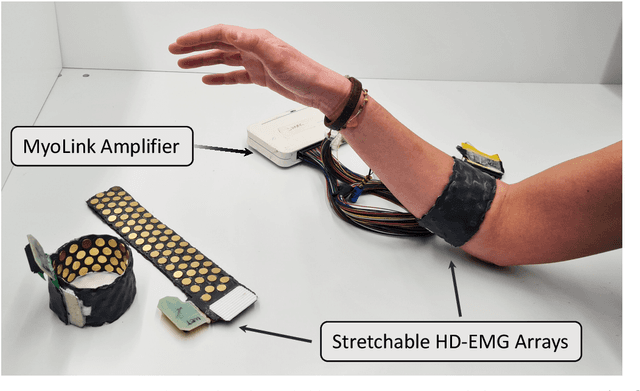

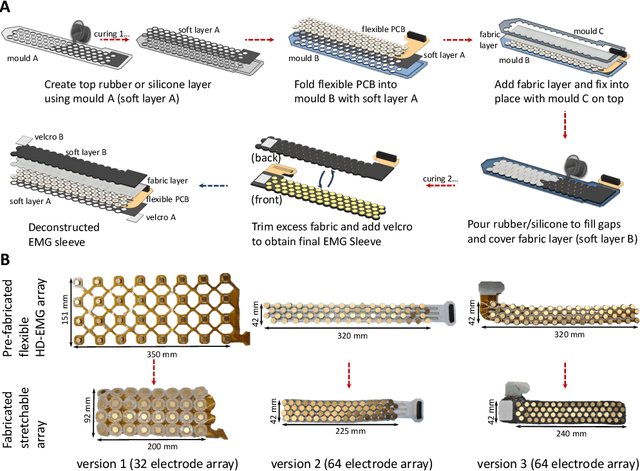
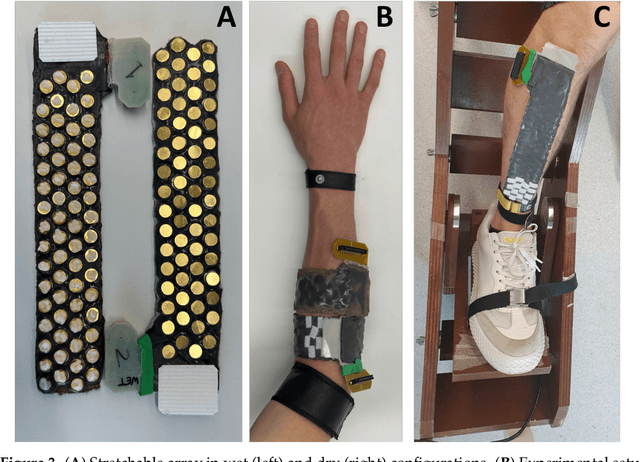
Abstract:The adoption of high-density electrode systems for human-machine interfaces in real-life applications has been impeded by practical and technical challenges, including noise interference, motion artifacts and the lack of compact electrode interfaces. To overcome some of these challenges, we introduce a wearable and stretchable electromyography (EMG) array, and present its design, fabrication methodology, characterisation, and comprehensive evaluation. Our proposed solution comprises dry-electrodes on flexible printed circuit board (PCB) substrates, eliminating the need for time-consuming skin preparation. The proposed fabrication method allows the manufacturing of stretchable sleeves, with consistent and standardised coverage across subjects. We thoroughly tested our developed prototype, evaluating its potential for application in both research and real-world environments. The results of our study showed that the developed stretchable array matches or outperforms traditional EMG grids and holds promise in furthering the real-world translation of high-density EMG for human-machine interfaces.
* This is the author's version of the manuscript published in MDPI Sensors journal - https://www.mdpi.com/1424-8220/24/6/1810 , This manuscript is in IEEE format - 8 pages, 5 figures, 1 table
Design and Preliminary Evaluation of a Torso Stabiliser for Individuals with Spinal Cord Injury
Mar 26, 2024



Abstract:Spinal cord injuries (SCIs) generally result in sensory and mobility impairments, with torso instability being particularly debilitating. Existing torso stabilisers are often rigid and restrictive. This paper presents an early investigation into a non-restrictive 1 degree-of-freedom (DoF) mechanical torso stabiliser inspired by devices such as centrifugal clutches and seat-belt mechanisms. Firstly, the paper presents a motion-capture (MoCap) and OpenSim-based kinematic analysis of the cable-based system to understand requisite device characteristics. The simulated evaluation resulted in the cable-based device to require 55-60cm of unrestricted travel, and to lock at a threshold cable velocity of 80-100cm/sec. Next, the developed 1-DoF device is introduced. The proposed mechanical device is transparent during activities of daily living, and transitions to compliant blocking when incipient fall is detected. Prototype behaviour was then validated using a MoCap-based kinematic analysis to verify non-restrictive movement, reliable transition to blocking, and compliance of the blocking.
 Add to Chrome
Add to Chrome Add to Firefox
Add to Firefox Add to Edge
Add to Edge